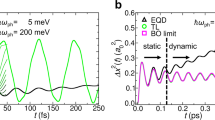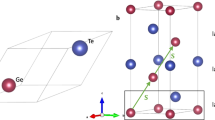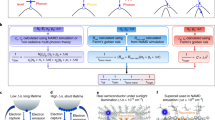Abstract
Application of the non-adiabatic molecular dynamics (NAMD) approach is limited to studying carrier dynamics in the momentum space, as a supercell is required to sample the phonon excitation and electron–phonon (e–ph) interaction at different momenta in a molecular dynamics simulation. Here we develop an ab initio approach for the real-time charge carrier quantum dynamics in the momentum space (NAMD_k) by directly introducing e–ph coupling into the Hamiltonian based on the harmonic approximation. The NAMD_k approach maintains the zero-point energy and includes memory effects of carrier dynamics. The application of NAMD_k to the hot carrier dynamics in graphene reveals the phonon-specific relaxation mechanism. An energy threshold of 0.2 eV—defined by two optical phonon modes—separates the hot electron relaxation into fast and slow regions with lifetimes of pico- and nanoseconds, respectively. The NAMD_k approach provides an effective tool to understand real-time carrier dynamics in the momentum space for different materials.
This is a preview of subscription content, access via your institution
Access options
Access Nature and 54 other Nature Portfolio journals
Get Nature+, our best-value online-access subscription
$29.99 / 30 days
cancel any time
Subscribe to this journal
Receive 12 digital issues and online access to articles
$99.00 per year
only $8.25 per issue
Buy this article
- Purchase on Springer Link
- Instant access to full article PDF
Prices may be subject to local taxes which are calculated during checkout





Similar content being viewed by others
Data availability
These data are obtained by NAMD_k simulations using our homemade code56,57. The source data for Figs. 1–5, Supplementary Figs. 1–3 and input files for NAMD_k simulations have been deposited in the Materials Cloud Archive at https://doi.org/10.24435/materialscloud:2n-3j. Source Data are provided with this paper.
Code availability
The code for our algorithm and a guide to reproducing the results is available at GitHub56 and Code Ocean57. In the calculation, e–ph coupling is calculated by the package Perturbo58, which can be obtained at https://perturbo-code.github.io.
Change history
15 June 2023
In the version of this article initially published, a reference (https://doi.org/10.1016/j.cpc.2021.107970) for the Perturbo software package listed in the Code availability section was missing and has now been amended in the HTML and PDF versions of the article.
References
Tisdale, W. A. et al. Hot-electron transfer from semiconductor nanocrystals. Science 328, 1543–1547 (2010).
Akimov, A. V., Neukirch, A. J. & Prezhdo, O. V. Theoretical insights into photoinduced charge transfer and catalysis at oxide interfaces. Chem. Rev. 113, 4496–4565 (2013).
Zheng, Q. et al. Ab initio nonadiabatic molecular dynamics investigations on the excited carriers in condensed matter systems. WIREs Comput. Mol. Sci. 9, 1411 (2019).
Sobota, J. A., He, Y. & Shen, Z.-X. Angle-resolved photoemission studies of quantum materials. Rev. Modern Phys. 93, 025006 (2021).
Poncé, S., Li, W., Reichardt, S. & Giustino, F. First-principles calculations of charge carrier mobility and conductivity in bulk semiconductors and two-dimensional materials. Rep. Prog. Phys. 83, 036501 (2020).
Bernardi, M. First-principles dynamics of electrons and phonons*. Eur. Phys. J. B 89, 239 (2016).
Jhalani, V. A., Zhou, J.-J. & Bernardi, M. Ultrafast hot carrier dynamics in gan and its impact on the efficiency droop. Nano Lett. 17, 5012–5019 (2017).
Tong, X. & Bernardi, M. Toward precise simulations of the coupled ultrafast dynamics of electrons and atomic vibrations in materials. Phys. Rev. Res. 3, 023072 (2021).
Li, X., Tully, J. C., Schlegel, H. B. & Frisch, M. J. Ab initio ehrenfest dynamics. J. Chem. Phys. 123, 084106 (2005).
Meng, S. & Kaxiras, E. Real-time, local basis-set implementation of time-dependent density functional theory for excited state dynamics simulations. J. Chem. Phys. 129, 054110 (2008).
Kolesov, G., Granas, O., Hoyt, R., Vinichenko, D. & Kaxiras, E. Real-time TD-DFT with classical ion dynamics: methodology and applications. J. Chem. Theory Comput. 12, 466–476 (2016).
Wang, Z., Li, S.-S. & Wang, L.-W. Efficient real-time time-dependent density functional theory method and its application to a collision of an ion with a 2D material. Phys. Rev. Lett. 114, 063004 (2015).
Runge, E. & Gross, E. K. U. Density-functional theory for time-dependent systems. Phys. Rev. Lett. 52, 997–1000 (1984).
Schleife, A., Draeger, E. W., Kanai, Y. & Correa, A. A. Plane-wave pseudopotential implementation of explicit integrators for time-dependent Kohn–Sham equations in large-scale simulations. J. Chem. Phys. 137, 22–546 (2012).
Shepard, C., Zhou, R., Yost, D. C., Yao, Y. & Kanai, Y. Simulating electronic excitation and dynamics with real-time propagation approach to TDDFT within plane-wave pseudopotential formulation. J. Chem. Phys. 155, 100901 (2021).
Akimov, A. V. & Prezhdo, O. V. The pyxaid program for non-adiabatic molecular dynamics in condensed matter systems. J Chem. Theory Comput. 9, 4959–72 (2013).
Tully, J. C. Molecular dynamics with electronic transitions. J. Chem. Phys. 93, 1061–1071 (1990).
Cui, G. & Thiel, W. Generalized trajectory surface-hopping method for internal conversion and intersystem crossing. J. Chem. Phys. 141, 124101 (2014).
Zhang, X., Li, Z. & Lu, G. First-principles determination of charge carrier mobility in disordered semiconducting polymers. Phys. Rev. B 82, 205210 (2010).
Jiang, X. et al. Real-time GW-BSE investigations on spin-valley exciton dynamics in monolayer transition metal dichalcogenide. Sci. Adv. 7, 3759 (2021).
Liu, J., Zhang, X. & Lu, G. Excitonic effect drives ultrafast dynamics in van der waals heterostructures. Nano Lett. 20, 4631–4637 (2020).
Zheng, Q. et al. Phonon-assisted ultrafast charge transfer at van der waals heterostructure interface. Nano Lett. 17, 6435–6442 (2017).
Li, W., Zhou, L., Prezhdo, O. V. & Akimov, A. V. Spin-orbit interactions greatly accelerate nonradiative dynamics in lead halide perovskites. ACS Energy Lett. 3, 2159–2166 (2018).
Zheng, Z., Zheng, Q. & Zhao, J. Spin-orbit coupling induced demagnetization in Ni: ab initio nonadiabatic molecular dynamics perspective. Phys. Rev. B 105, 085142 (2022).
Liu, X.-Y. et al. Spin-orbit coupling accelerates the photoinduced interfacial electron transfer in a fullerene-based perovskite heterojunction. J. Phys. Chem. Lett. 12, 1131–1137 (2021).
Sohier, T., Calandra, M. & Mauri, F. Density functional perturbation theory for gated two-dimensional heterostructures: theoretical developments and application to flexural phonons in graphene. Phys. Rev. B 96, 075448 (2017).
Monserrat, B. Electron–phonon coupling from finite differences. J. Phys. Condensed Matter 30, 083001 (2018).
Ye, Z.-Q., Cao, B.-Y., Yao, W.-J., Feng, T. & Ruan, X. Spectral phonon thermal properties in graphene nanoribbons. Carbon 93, 915–923 (2015).
Dal Conte, S. et al. Snapshots of the retarded interaction of charge carriers with ultrafast fluctuations in cuprates. Nat. Phys. 11, 421–426 (2015).
Park, C.-H., Giustino, F., Cohen, M. L. & Louie, S. G. Velocity renormalization and carrier lifetime in graphene from the electron–phonon interaction. Phys. Rev. Lett. 99, 086804 (2007).
Park, C.-H., Giustino, F., Cohen, M. L. & Louie, S. G. Electron–phonon interactions in graphene, bilayer graphene, and graphite. Nano Lett. 8, 4229–4233 (2008).
Gierz, I. et al. Snapshots of non-equilibrium dirac carrier distributions in graphene. Nat. Mater. 12, 1119–1124 (2013).
Johannsen, J. C. et al. Direct view of hot carrier dynamics in graphene. Phys. Rev. Lett. 111, 027403 (2013).
Gierz, I. et al. Tracking primary thermalization events in graphene with photoemission at extreme time scales. Phys. Rev. Lett. 115, 086803 (2015).
Na, M. X. et al. Direct determination of mode-projected electron-phonon coupling in the time domain. Science 366, 1231 (2019).
Kampfrath, T., Perfetti, L., Schapper, F., Frischkorn, C. & Wolf, M. Strongly coupled optical phonons in the ultrafast dynamics of the electronic energy and current relaxation in graphite. Phys. Rev. Lett. 95, 187403 (2005).
Stange, A. et al. Hot electron cooling in graphite: supercollision versus hot phonon decay. Phys. Rev. B 92, 184303 (2015).
Wang, H. et al. Ultrafast relaxation dynamics of hot optical phonons in graphene. Appl. Phys. Lett. 96, 081917 (2010).
Butscher, S., Milde, F., Hirtschulz, M., Malić, E. & Knorr, A. Hot electron relaxation and phonon dynamics in graphene. Appl. Phys. Lett. 91, 203103 (2007).
Strait, J. H. et al. Very slow cooling dynamics of photoexcited carriers in graphene observed by optical-pump terahertz-probe spectroscopy. Nano Lett. 11, 4902–4906 (2011).
Zhang, H. et al. Self-energy dynamics and the mode-specific phonon threshold effect in Kekulé-ordered graphene. Natl Sci. Rev. 9, 175 (2022).
Lian, C., Hu, S.-Q., Guan, M.-X. & Meng, S. Momentum-resolved TDDFT algorithm in atomic basis for real time tracking of electronic excitation. J. Chem. Phys. 149, 154104 (2018).
Bertsch, G. F., Iwata, J.-I., Rubio, A. & Yabana, K. Real-space, real-time method for the dielectric function. Phys. Rev. B 62, 7998–8002 (2000).
Marques, M. A. L., Castro, A., Bertsch, G. F. & Rubio, A. octopus: a first-principles tool for excited electron–ion dynamics. Comput. Phys. Commun. 151, 60–78 (2003).
Castro, A. et al. octopus: a tool for the application of time-dependent density functional theory. Phys. Status Solidi B 243, 2465–2488 (2006).
Andrade, X. et al. Real-space grids and the octopus code as tools for the development of new simulation approaches for electronic systems. Phys. Chem. Chem. Phys. 17, 31371–31396 (2015).
Hu, S.-Q. et al. Tracking photocarrier-enhanced electron–phonon coupling in nonequilibrium. npj Quantum Mater. 7, 14 (2022).
Chu, W. & Prezhdo, O. V. Concentric approximation for fast and accurate numerical evaluation of nonadiabatic coupling with projector augmented-wave pseudopotentials. J. Phys. Chem. Lett. 12, 3082–3089 (2021).
Chu, W. et al. Accurate computation of nonadiabatic coupling with projector augmented-wave pseudopotentials. J. Phys. Chem. Lett. 11, 10073–10080 (2020).
Fernandez-Alberti, S., Roitberg, A. E., Nelson, T. & Tretiak, S. Identification of unavoided crossings in nonadiabatic photoexcited dynamics involving multiple electronic states in polyatomic conjugated molecules. J. Chem. Phys. 137, 014512 (2012).
Qiu, J., Bai, X. & Wang, L. Crossing classified and corrected fewest switches surface hopping. J. Phys. Chem. Lett. 9, 4319–4325 (2018).
Wang, L. & Prezhdo, O. V. A simple solution to the trivial crossing problem in surface hopping. J. Phys. Chem. Lett. 5, 713–719 (2014).
Hale, P. J., Hornett, S. M., Moger, J., Horsell, D. W. & Hendry, E. Hot phonon decay in supported and suspended exfoliated graphene. Phys. Rev. B 83, 121404 (2011).
Chen, H.-Y., Sangalli, D. & Bernardi, M. Exciton-phonon interaction and relaxation times from first principles. Phys. Rev. Lett. 125, 107401 (2020).
Zheng, F., Tan, L. Z., Liu, S. & Rappe, A. M. Rashba spin-orbit coupling enhanced carrier lifetime in CH3NH3PbI3. Nano Lett. 15, 7794–7800 (2015).
Zheng, Z. & Zheng, Q. Hefei-NAMD-EPC v.1.10.6 (GitHub, 2023); https://github.com/ZhenfaZheng/NAMDinMomentumSpace.git
Zheng, Z. & Zheng, Q. Ab initio real-time quantum dynamics of charge carriers in momentum space. CodeOcean https://doi.org/10.24433/CO.4619996.v1 (2023).
Zhou, J.-J. et al. Perturbo: A software package for ab initio electron–phonon interactions, charge transport and ultrafast dynamics. Comput. Phys. Commun. https://doi.org/10.1016/j.cpc.2021.107970 (2021).
Acknowledgements
J.Z. acknowledges the support of the Innovation Program for Quantum Science and Technology (grant no. 2021ZD0303306); the National Natural Science Foundation of China (NSFC, grant nos. 12125408 and 11974322); and the informatization plan of Chinese Academy of Sciences (grant no. CAS-WX2021SF-0105). Q.Z. acknowledges the support of the NSFC (grant no. 12174363). O.V.P. acknowledges funding of the US National Science Foundation (grant no. CHE-2154367). Calculations were performed at the Hefei Advanced Computing Center, the Supercomputing Center at USTC, and the ORISE Supercomputer. We received no specific funding for this work.
Author information
Authors and Affiliations
Contributions
Y.S. contributed to this work before March 2022. J.Z. supervised the research project. Y.S. conceived the original idea. J.Z., Q.Z., Y.S. and Z.Z. developed the method, whereas J.-J.Z. and O.V.P. provided suggestions to improve the method. Q.Z. constructed the original Hefei-NAMD code. Z.Z. developed the NAMD_k version of Hefei-NAMD on the basis of the original Hefei-NAMD code, performed the NAMD_k simulation of graphene, and data analysis, with help from Q.Z. J.-J.Z. provided the patch of PERTURBO package for outputting e–ph matrix elements data. J.Z., Q.Z. and Z.Z. wrote the manuscript. The manuscript reflects the contributions of all authors.
Corresponding authors
Ethics declarations
Competing interests
The authors declare no competing interests.
Peer review
Peer review information
Nature Computational Science thanks Jun Yin, Sergei Tretiak, and the other, anonymous, reviewer(s) for their contribution to the peer review of this work. Primary Handling Editor: Jie Pan, in collaboration with the Nature Computational Science team.
Additional information
Publisher’s note Springer Nature remains neutral with regard to jurisdictional claims in published maps and institutional affiliations.
Supplementary information
Supplementary Information
Proof of zero non-adiabatic coupling for Bloch states with different momenta, and Supplementary Figs. 1–3.
Supplementary Data 1
Source data for Supplementary Fig. 1.
Supplementary Data 2
Source data for Supplementary Fig. 2.
Supplementary Data 3
Source data for Supplementary Fig. 3.
Source data
Source Data Fig. 1
Statistical source data.
Source Data Fig. 2
Statistical source data.
Source Data Fig. 3
Statistical source data.
Source Data Fig. 4
Statistical source data.
Source Data Fig. 5
Statistical source data.
Rights and permissions
Springer Nature or its licensor (e.g. a society or other partner) holds exclusive rights to this article under a publishing agreement with the author(s) or other rightsholder(s); author self-archiving of the accepted manuscript version of this article is solely governed by the terms of such publishing agreement and applicable law.
About this article
Cite this article
Zheng, Z., Shi, Y., Zhou, JJ. et al. Ab initio real-time quantum dynamics of charge carriers in momentum space. Nat Comput Sci 3, 532–541 (2023). https://doi.org/10.1038/s43588-023-00456-9
Received:
Accepted:
Published:
Issue Date:
DOI: https://doi.org/10.1038/s43588-023-00456-9
This article is cited by
-
Computing electron dynamics in momentum space
Nature Computational Science (2023)



